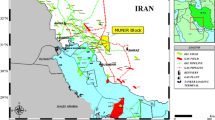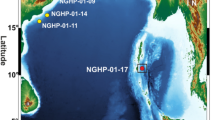Abstract
Identification of the geological facies and their distribution from seismic and other available geological information is important during the early stage of reservoir development (e.g. decision on initial well locations). Traditionally, this is done by manually inspecting the signatures of the seismic attribute maps, which is very time-consuming. This paper proposes an application of the Expectation-Maximization (EM) algorithm to automatically identify geological facies from seismic data. While the properties within a certain geological facies are relatively homogeneous, the properties between geological facies can be rather different. Assuming that noisy seismic data of a geological facies, which reflect rock properties, can be approximated with a Gaussian distribution, the seismic data of a reservoir composed of several geological facies are samples from a Gaussian mixture model. The mean of each Gaussian model represents the average value of the seismic data within each facies while the variance gives the variation of the seismic data within a facies. The proportions in the Gaussian mixture model represent the relative volumes of different facies in the reservoir. In this setting, the facies classification problem becomes a problem of estimating the parameters defining the Gaussian mixture model. The EM algorithm has long been used to estimate Gaussian mixture model parameters. As the standard EM algorithm does not consider spatial relationship among data, it can generate spatially scattered seismic facies which is physically unrealistic. We improve the standard EM algorithm by adding a spatial constraint to enhance spatial continuity of the estimated geological facies. By applying the EM algorithms to acoustic impedance and Poisson’s ratio data for two synthetic examples, we are able to identify the facies distribution.
Similar content being viewed by others
References
Allard, D., Guillot, G.: Clustering Geostatistical Data, Geostatistics 2000, vol. 1, pp. 49–63. Cape Town (1999)
Ambroise, C., Dang, M., Govaert, G.: Convergence of an EM-type algorithm for spatial clustering. Pattern Recogn. Lett. 19, 919–927 (1998)
Aminzadeh, I.F., Chattcsjee, S.: Applications of clustering in exploration seismology. Geoexploration 23(1), 147–159 (1984)
Arpat, B.G., Caers, J., Haas, A.: Characterization of west-Africa submarine channel reservoirs: a neural network based approach to integration of seismic data. In: 2001 SPE Annual Technical Conference and Exhibition (2001)
Besag, J.E.: On the statistical analysis of dirty pictures. J. R. Stat. Soc., Ser. B 48(3), 295–302 (1986)
Caers, J.: Petroleum Geostatistics. Society of Petroleum Engineers, Richardson, Texas (2005)
Celeux, G., Govaert, G.: A classification EM Algorithm for Clustering and Two Stochastic Versions. Rapports de Recherche (1991)
Dempster, A.P., Laird, N.M., Rubin, D.B.: Maximum likelihood from incomplete data via the EM algorithm. J. Roy. Statist. Soc. B 39(1), 1–38 (1977)
Diplaros, A., Gevers, T., Vlassis, N.: Skin detection using the EM algorithm with spatial constraints, systems, man and cybernetics. In: 2004 IEEE International Conference, vol. 4 (2004)
Dong, Y., Oliver, D.S.: Quantitative use of 4D seismic data for reservoir description. SPE J. 10(1), 51–65 (2005)
Han, M.: Application of the EM algorithms for facies classfication and measurement error estimation. M.S. Thesis, University of Tulsa, Tulsa, Oklahoma, USA (2008)
Hartley, H.: Maximum likelihood from incomplete data. Biometrics 14(1), 174–194 (1958)
John, A., Lake, L.W., Torres-Verdin, C., Srinivasan, S.: Seismic facies identication and classication using simple statistics. SPE Reserv. Evalu. Eng. 11(6), 984–990 (2005)
Kung, S., Mak, M., Lin, S.: Biometric Authentication: A Machine Learning Approach. Prentice Hall (2004)
Liu, N., Oliver, D.S.: Critical evaluation of the ensemble Kalman filter on history matching geological facies. SPE Reserv. Evalu. Eng. 8(4) 470–477 (2005)
Meng, X.-L.: On the rate of convergence of the ECM algorithm. Ann. Stat. 22(1), 326–339 (1994)
Ng, I., Kittler, J., Illingworth, J.: Supervised segmentation using a multiresolution data representation. Signal Process. 3, 36–44 (1993)
Pitas, I., Kotropoulos, C.: A texture-based approach to the segmentation of seismic images. Pattern Recogn. 25, 929–945 (1992)
Redner, R.A., Walker, H.F.: Mixture densities, maximum likelihood and the EM algorithm. SIAM Rev. 26(2), 195–239 (1984)
Tang, H., Ji, H.: Incorporation of spatial characteristics into volcanic facies and favorable reservoir prediction. In: 2004 SPE Annual Technical Conference and Exhibition (2004)
Teixeira, R., Braga, I., Loures, L.: Bayesian characterization of subsurface lithofacies and saturation fluid. In: 2007 SPE Latin American and Caribbean Petroleum Engineering Conference (2007)
Wiseman, S.: Seismic image segmentation. In: 1999 European Assoc. of Geoscientists and Engineers Conference (1999)
Zhao, Y., Li, G., Reynolds, A.C.: Characterizing the measurement error with the EM algorithm. In: Proceedings of 10th European Conference on the Mathematics of Oil Recovery (2006)
Zhao, Y., Li, G., Reynolds, A.C.: Generating facies maps by assimilating production data and seismic data with the ensemble Kalman filter. In: Proceedings of 2008 SPE/DOE Improved Oil Recovery Symposium (2008)
Zhao, Y., Li, G., Reynolds, A.C.: Characterization of the measurement error in time-lapse seismic data and production data with an EM algorithm. Oil Gas Sci. Technol. - Rev. IFP 62(2), 181–193 (2007)
Author information
Authors and Affiliations
Corresponding author
Rights and permissions
About this article
Cite this article
Han, M., Zhao, Y., Li, G. et al. Application of EM algorithms for seismic facices classification. Comput Geosci 15, 421–429 (2011). https://doi.org/10.1007/s10596-010-9212-4
Received:
Accepted:
Published:
Issue Date:
DOI: https://doi.org/10.1007/s10596-010-9212-4




